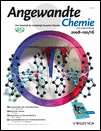Ein einfacher Zugang zu Vinigrol†
Thomas J. Maimone
Department of Chemistry, The Scripps Research Institute, 10650 North Torrey Pines Road, La Jolla, CA 92037, USA, Fax: (+1) 858-784-7375
Search for more papers by this authorAna-Florina Voica
Department of Chemistry, The Scripps Research Institute, 10650 North Torrey Pines Road, La Jolla, CA 92037, USA, Fax: (+1) 858-784-7375
Search for more papers by this authorPhil S. Baran Prof.
Department of Chemistry, The Scripps Research Institute, 10650 North Torrey Pines Road, La Jolla, CA 92037, USA, Fax: (+1) 858-784-7375
Search for more papers by this authorThomas J. Maimone
Department of Chemistry, The Scripps Research Institute, 10650 North Torrey Pines Road, La Jolla, CA 92037, USA, Fax: (+1) 858-784-7375
Search for more papers by this authorAna-Florina Voica
Department of Chemistry, The Scripps Research Institute, 10650 North Torrey Pines Road, La Jolla, CA 92037, USA, Fax: (+1) 858-784-7375
Search for more papers by this authorPhil S. Baran Prof.
Department of Chemistry, The Scripps Research Institute, 10650 North Torrey Pines Road, La Jolla, CA 92037, USA, Fax: (+1) 858-784-7375
Search for more papers by this authorWir danken Dr. D.-H. Huang und Dr. L. Pasternack (NMR-Spektroskopie), Dr. G. Siuzdak (Massenspektrometrie), Dr. Arnold Rheingold (UCSD; Röntgenkristallographie) und Dr. Niklas Schöne (Übersetzung). Diese Arbeit wurde durch Bristol-Myers Squibb (Graduiertenstipendium für T.J.M.), Merck und Roche finanziell unterstützt.
Graphical Abstract
Kurz und bündig: Eine einfache und praktische Route zum ungewöhnlichen tricyclischen Ringsystem des biologisch aktiven Diterpens Vinigrol wird beschrieben. Eine „nachbarschaftinduzierte“ intramolekulare Cycloaddition und eine Grob-Fragmentierung ermöglichten den schnellen Aufbau des Ringsystems in weniger als zehn Stufen und mit minimalen Schutzgruppenoperationen.
Supporting Information
Supporting information for this article is available on the WWW under http://www.wiley-vch.de/contents/jc_2001/2008/z800167_s.pdf or from the author.
Please note: The publisher is not responsible for the content or functionality of any supporting information supplied by the authors. Any queries (other than missing content) should be directed to the corresponding author for the article.
References
- 1I. Uchida, T. Ando, N. Fukami, K. Yoshida, M. Hashimoto, T. Tada, S. Koda, Y. Morimoto, J. Org. Chem. 1987, 52, 5292–5293.
- 2
- 2aT. Ando, Y. Tsurumi, N. Ohata, I. Uchida, K. Yoshida, M. Okuhara, J. Antibiot. 1988, 41, 25–30;
- 2bT. Ando, K. Yoshida, M. Okuhara, J. Antibiot. 1988, 41, 31–35;
- 2cD. B. Norris, P. Depledge, A. P. Jackson, PCT Int. Appl. WO 9107 953, 1991;
- 2dH. Nakajima, N. Yamamoto, T. Kaizu, T. Kino (Jpn. Kokai Tokkyo Koho), JP 07-206668, 1995.
- 3Studien zur Synthese von Vinigrol:
- 3aL. A. Paquette, R. Guevel, S. Sakamoto, I. H. Kim, J. Crawford, J. Org. Chem. 2003, 68, 6096–6107;
- 3bL. A. Paquette, I. Efremov, Z. S. Liu, J. Org. Chem. 2005, 70, 505–509;
- 3cL. A. Paquette, I. Efremov, J. Org. Chem. 2005, 70, 510–513;
- 3dL. A. Paquette, Z. S. Liu, I. Efremov, J. Org. Chem. 2005, 70, 514–518;
- 3ediese Möglichkeit der Bindungsspaltung war bereits erkannt worden: S. N. Goodman, Ph.D. Thesis, Harvard University, 2000;
- 3fC. M. Grise, G. Tessier, L. Barriault, Org. Lett. 2007, 9, 1545–1548;
- 3gL. Morency, L. Barriault, J. Org. Chem. 2005, 70, 8841–8853;
- 3hL. Morency, L. Barriault, Tetrahedron Lett. 2004, 45, 6105–6107;
- 3iJ. G. Devaux, I. Hanna, J. Y. Lallemand, J. Org. Chem. 1997, 62, 5062–5068;
- 3jJ. F. Devaux, I. Hanna, J. Y. Lallemand, J. Org. Chem. 1993, 58, 2349–2350;
- 3kL. Gentric, I. Hanna, L. Ricard, Org. Lett. 2003, 5, 1139–1142;
- 3lG. Mehta, K. S. Reddy, Synlett 1996, 625–627;
- 3mM. Kito, T. Sakai, N. Haruta, H. Shirahama, F. Matsuda, Synlett 1996, 1057–1060;
- 3nM. Kito, T. Sakai, H. Shirahama, M. Miyashita, F. Matsuda, Synlett 1997, 219–220;
- 3oF. Matsuda, M. Kito, T. Sakai, N. Okada, M. Miyashita, H. Shirahama, Tetrahedron 1999, 55, 14369–14380;
- 3pM. S. Souweha, G. D. Enright, A. G. Fallis, Org. Lett. 2007, 9, 5163–5166;
- 3qG. Tessier, L. Barriault, Org. Prep. Proc. Int. 2007, 39, 311–353;
- 3rJ.-F. Devaux, I. Hanna, J.-Y. Lallemand, T. Prange, J. Chem. Res. Syn. 1996, 32–33.
- 4T. J. Maimone, P. S. Baran, Nat. Chem. Biol. 2007, 3, 396–407.
- 5H. Lamy-Schelkens, D. Giomi, L. Ghosez, Tetrahedron Lett. 1989, 30, 5887–5890.
- 6K. C. Nicolaou, P. G. Bulger, D. Sarlah, Angew. Chem. 2005, 117, 4516–4563;
10.1002/ange.200500368 Google ScholarAngew. Chem. Int. Ed. 2005, 44, 4442–4489.
- 7Ein frühes Beispiel einer intramolekularen Diels-Alder-Reaktion zwischen unaktivierten π-Systemen (160–190 °C):
- 7aS. R. Wilson, D. T. Mao, J. Am. Chem. Soc. 1978, 100, 6289–6291; eine Übersicht zur Anwendung der Diels-Alder-Reaktion in der Totalsynthese:
- 7bK. C. Nicolaou, S. A. Snyder, T. Montagnon, G. Vassilikogiannakis, Angew. Chem. 2002, 114, 1742–1773;
10.1002/1521-3757(20020517)114:10<1742::AID-ANGE1742>3.0.CO;2-Y Google ScholarAngew. Chem. Int. Ed. 2002, 41, 1668–1698; eine allgemeine Übersicht über intramolekulare Diels-Alder-Reaktionen:10.1002/1521-3773(20020517)41:10<1668::AID-ANIE1668>3.0.CO;2-Z CAS PubMed Web of Science® Google Scholar
- 7cW. R. Roush in Comprehensive Organic Synthesis, Vol. 5 (Hrsg.: ), Pergamon, Oxford, 1991, S. 513–550;
10.1016/B978-0-08-052349-1.00131-1 Google Scholar
- 7dG. Brieger, J. N. Bennett, Chem. Rev. 1980, 80, 63–97;
- 7eB. R. Bear, S. M. Sparks, K. J. Shea, Angew. Chem. 2001, 113, 864–894;
10.1002/1521-3757(20010302)113:5<864::AID-ANGE864>3.0.CO;2-0 Google ScholarAngew. Chem. Int. Ed. 2001, 40, 820–849;10.1002/1521-3773(20010302)40:5<820::AID-ANIE820>3.0.CO;2-F CAS PubMed Web of Science® Google Scholar
- 7fK. Takao, R. Munakata, K. Tadano, Chem. Rev. 2005, 105, 4779–4807.
- 8T.-L. Ho, Heterolytic Fragmentation of Organic Molecules, Wiley, New York, 1993.
- 9P. S. Baran, T. J. Maimone, J. M. Richter, Nature 2007, 446, 404–408. Da die Silylgruppen benötigt werden, um die Dien-Form von 8 zu ermöglichen, sind sie nicht als Schutzgruppen anzusehen. Eine Diskussion: R. W. Hoffmann, Synthesis 2006, 3531–3541.
- 10Vollständige Charakterisierungen und experimentelle Details sind in den Hintergrundinformationen zu finden. CCDC 675358 (5), 675356 (13) und 67535 (15) enthalten die ausführlichen kristallographischen Daten zu dieser Veröffentlichung. Die Daten sind kostenlos beim Cambridge Crystallographic Data Centre über www.ccdc.cam.ac.uk/data_request/cif erhältlich.
Citing Literature
This is the
German version
of Angewandte Chemie.
Note for articles published since 1962:
Do not cite this version alone.
Take me to the International Edition version with citable page numbers, DOI, and citation export.
We apologize for the inconvenience.





